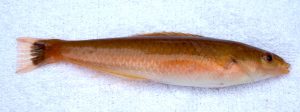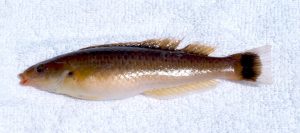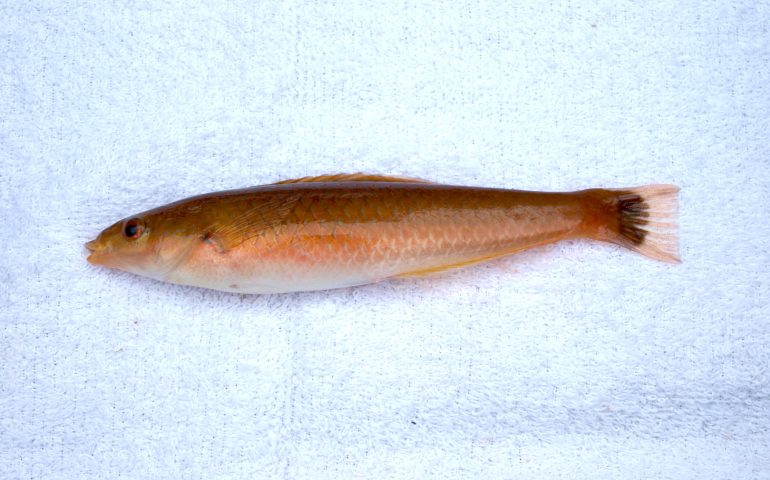Wrasses: Family Labridae
Species: Oxyjulis californica (Gunther, 1861); from the Greek words oxy (sharp, for sharp nosed fish) and julis (an old world genus of wrasses), and californica (from California, the location of the first fish studied).
Alternate Names: Kelp fish, kelp wrasse, butterfish, iodine fish and cigar fish. Called pescery by 19th century Italian fishermen; Chinese smelt by some early SoCal anglers. Also called Señorita in Mexico.

Size: To 10 inches although most caught from piers are 6-8 inches.
Range: Bahia Magdalena, southern Baja California, to Salt Point, Sonoma County, northern California. Common from Bahia San Juanico, southern Baja California, to central California. Rarely caught north of Santa Cruz.

Habitat: Generally found in shallow-water, rocky-shore areas, or near kelp beds although recorded to a depth of 331 feet. Usually found in small to dense schools. Senorita are carnivores that feed on small animals and the animals can be located on plants, other animals, in the water or on the bottom. They will pick parasites from other fish and are apparently sought out by a diverse group that includes bat rays, giant (black) sea bass, kelp bass garibaldi, halfmoon, opaleye and mola. It’s reported many fish will maintain awkward positions while being “cleaned” and that garibaldi actually hold their gill slits open for removal of parasites in the gill chamber. Considering that the “ectoparasites” removed includes bacteria, copepods, and isopods, it’s easy to see why the larger fish would be willing to maintain a weird position or two.
Piers: I have only seen these caught on a few piers but where present they are the proverbial “bait stealers” for the most part. However, they can be caught at almost any southern California pier located near rocks, reefs or kelp beds. Best bets: Oceanside Harbor Pier, Green Pleasure Pier at Avalon (where they are far too common), Cabrillo Mole (Avalon), Redondo Harbor Sportfishing Pier, Paradise Cove Pier, Gaviota Pier in the fall, and Monterey Wharf No. 2 (where they also are sometimes far too common).
Shoreline: Taken in rocky areas from southern California up to Monterey.
Boats: Occasionally taken by boat anglers fishing on the bottom.
Bait and Tackle: Winner of the MNBS Award: Most Notorious Bait Stealer Award. Señorita will try to grab (steal) almost any bait that is in their immediate vicinity. If you want to catch them use a small hook, size 6 or 8, and a small piece of mussel, shrimp or worm. Drop your bait to the bottom and then move it up in short increments until you find the school, or perhaps more accurately, until they find your bait—and they will.
Food Value: Really too small to eat since a 9-inch señorita only weighs about three ounces. Nevertheless, some people claim to find their “different” flavor delicious and they eat them, others say they have a slight iodine taste. One angler who likes to catch and eat señorita reported that the meat was soft and flakey.
Comments: As discussed in Fishes, An Introduction to Ichthyology, by Peter Moyle and Joseph Cech, señorita apparently are sometimes involved, in a complex manner, in helping to restore kelp beds: “Occasionally a severe storm will destroy a kelp forest, and regeneration may be prevented by the grazing of fishes or sea urchins on new kelp plants. Regeneration can occur, however, if rapidly growing green algae colonize the area first, providing the new kelp plants with shelter from grazing fishes (Harris et al. 1984). One of these grazers is the señorita, which is actually after a small bryozoan that encrusts the blades of plants. In order to eat the bryozoans, the señorita has to take bites from the blades; this can seriously weaken the plant if it is small, but has little effect when the plant is large. There is, however, another invertebrate, a herbivorous isopod, than can become so abundant it can destroy mature kelp plants. The señorita is the main predator on this isopod and keeps its populations small, maintaining the kelp beds in the process (Bernstein and Jung 1979). “
Señorita are attractive little fish that seem best suited for saltwater aquariums, or simply to be left alone since they seem to do quite a bit of good. Problem is they won’t leave bait alone. It is reported that they bury themselves at night in the sand with just their heads sticking out. Since they’re typically found in fairly large congregations, their nesting area must look a little strange. Perhaps like some sort of a weird colored, underwater asparagus patch.
